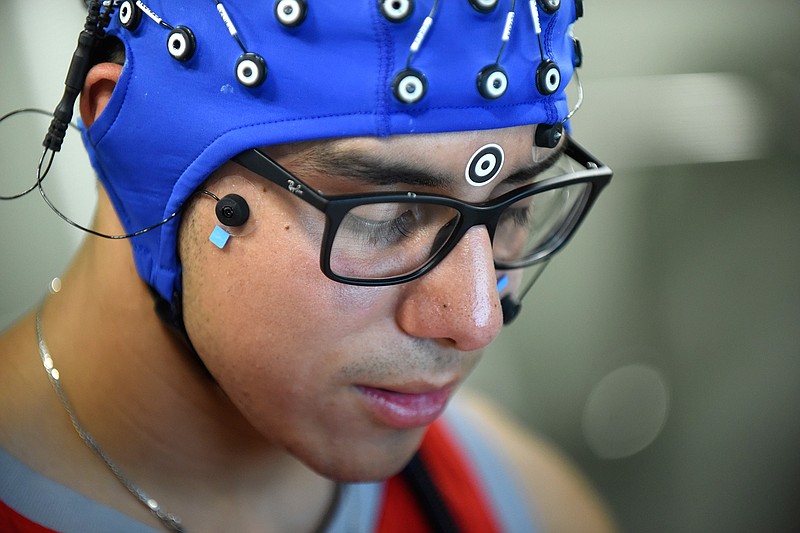SAN ANTONIO-Inside a large sound booth, Jack Rodriguez sat in a padded tan chair, a blue cap covering his head.
The San Antonio Express-News reports for about two hours, the college student's task was to read aloud the nonsensical words flashing on the screen in front of him.
"Sancration zathion"
"Fexon lomble"
"Kightmase narire"
Researchers designed the words to trigger Rodriguez's stuttering, as they try to better understand what is happening in his brain when he does.
Outside the booth, they were monitoring a video feed of Rodriguez and his brain activity. The cap was covered with electrodes that measure the electrical activity emitting from his scalp, signals that were fed to and analyzed by a computer.
The exercise is part of a two-year study of the role brain activity patterns play in people who stutter. The research, funded by a $387,000 grant from the National Institutes of Health, could potentially be used to help train people's brains to reduce their stuttering, said Edward Golob, a psychology professor at the University of Texas at San Antonio and the study's principal investigator.
Stuttering is a speech disorder that affects about 3 million people in the United States. People who stutter develop "disfluencies" that impede the flow of their speech. The condition can manifest in different ways-such as repetitions or drawn-out sounds in pronunciation, or difficulty producing words altogether-and to different degrees, depending on the person. It can grow more severe under certain circumstances, such as when the speaker becomes anxious or stressed.
Golob, who has studied stuttering for years, said he is interested in the varied nature of the condition.
"What captured my interest wasn't so much that people stuttered. It was that they would stutter and then they would be fluent and then they would stutter again," Golob said. "Typically with most neurological disorders, you don't see this flip-flopping back and forth between normal and abnormal that's that dramatic."
To better understand what is happening in the brain during those speech fluctuations, Golob and his team are gathering data on the stuttering patterns of people 18 and older. Over the course of multiple sessions, participants wear caps that measure their brain activity while they read aloud pairs of made-up "pseudo words" meant to elicit their stuttering.
In one exercise, participants are shown the paired words before they are prompted to say them aloud. In another, they are given a signal priming them to speak, then read the words as soon as they appear on the screen.
By increasing the incidences of stuttering, the researchers can build an accurate model of the person's brain activity during fluent and disfluent speech.
The best way to do that, said Jeffrey Mock, an assistant professor of research in UTSA's psychology department, is to present them with a difficult speech task that prompts
stuttering.
"We're trying to stress the system as much as possible to increase the number of disfluent trials," Mock said.
If the team can determine when someone is likely to stutter based on their brain activity, then they may be able to help that person maintain normal speech more often, Mock said.
However, the team does not expect to completely halt stuttering. The work may provide an additional tool to help those who stutter to better cope with the condition, alongside other resources like behavioral therapy, said Farzan Irani, an assistant professor of communication disorders at Texas State University who is part of the research team.
"They will continue to have moments of stuttering, but we are hoping it will be fewer and more spread out," Irani said.
Stuttering can sometimes be debilitating, Irani said, especially when people let it dictate their lives, such as choosing careers that do not require much conversation with others.
Rodriguez has stuttered his entire life, but two years ago, as a high school senior, he was caught in the throes of a particularly severe period with the disorder. For several excruciating weeks, it was as if he had hit a "brick wall," he said. When another person approached him, he grew anxious that he'd have to converse.
"I couldn't get out one word. I couldn't even start the word," said Rodriguez, now a sophomore at Texas State. He said he felt isolated and unable to communicate with those around him.
Eventually, Rodriguez was able to move past that obstacle and return to speech that was affected but not entirely halted by stuttering. He remained intrigued by the science behind the condition that affects his speech, and that of his father.
That interest in the underlying causes of his stuttering fueled his desire to join the study, which he learned about after attending a summer speech clinic run by Irani.
It was both difficult and fun articulating the bizarre words, Rodriguez said. During an earlier session, he found himself laughing after each attempt.
Participating in the clinic and the research has made him feel less alone, said Rodriguez, who has considered becoming a speech therapist himself.
"I got all these people around me that go through the same thing. I thought I was the only one that went through that," he said.

